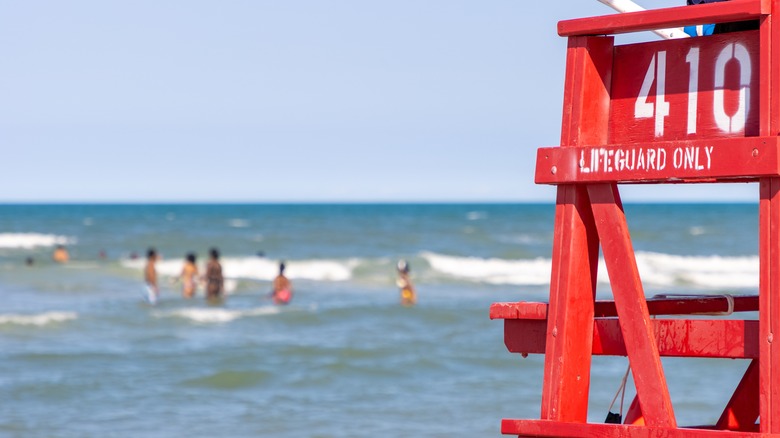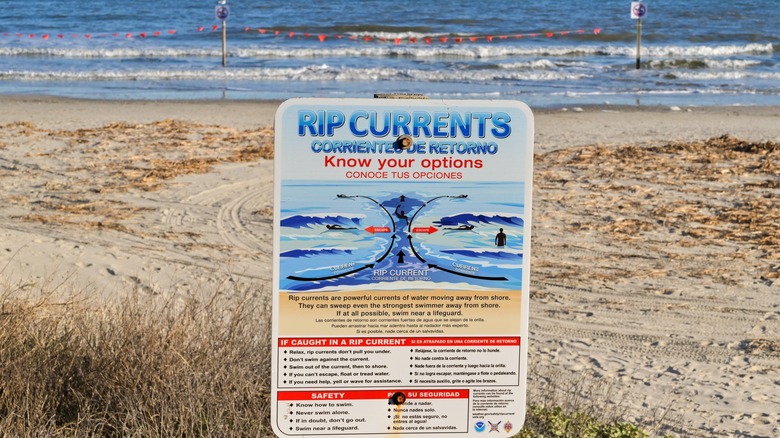What Is A Riptide And How Can You Stay Safe If You Get Stuck In One?
It seems as if virtually everyone loves a day at the beach. So much so that it is estimated a mind-boggling 80 percent of tourism activities around the world take place in coastal destinations. In the United States alone it is estimated there are more than two billion day trips to beaches each year. While each trip to the beach begins with the promise of fun, unfortunately, far too many end with the tragedy of a drowning. As noted by the CDC, between 2020 and 2022, more than 4,500 people drowned each year in the United States. According to the United States Lifesaving Association, the odds of drowning on a beach staffed with lifeguards is far less than when swimming on an unguarded beach.
The reason drowning numbers drop on guarded beaches is not only due to the fact someone is there to respond. It is also because lifeguards are very aware of one of the unexpected dangers of the beach –- riptides. While most people swimming in the surf are mostly concerned with dangerous sharks and other marine life, the biggest threat to their lives is actually the water itself. Riptides, not sharks or stingrays, are what make the beach one of the deadliest places to swim. Before your next trip to the shore, be sure you know what a riptide is and how to stay safe if you get stuck in one.
What is a riptide?
Of course, it is next to impossible to protect yourself from a threat you don't even know exists. Indeed, many swimmers who fall victim to a riptide were unaware of what they were, how to identify them, or how to react if caught in one. So, what is a riptide? In simple terms, riptides are strong currents that pull away from shore. They occur on every surf beach around the world. Riptides are also found along beaches of the Great Lakes. They usually appear at gaps or breaks in sand bars that run parallel to a beach or near structures such as piers, jetties, or breakwaters.
The danger of these tides is two-fold. One, these currents can be very strong. Strong enough that they can quickly become too powerful for even strong swimmers to make headway against. Secondly, they pull people away from shore into deeper water. The fact they flow away from shore, in the opposite direction of the waves, can be quite confusing. However, that also makes rip currents fairly easy to spot, and thus avoid, if you know what to look for. One of the clues that there is a riptide is if there appears to be a gap between lines of breaking waves. Any foam, seaweed, debris, or visible current flowing out through the surf toward open water is another sure sign of a riptide.
How to safely escape a riptide
Riptides are the reason behind over 80 percent of rescues on U.S. beaches. However, it is possible to safely swim at the beach. Be sure to observe and heed any warning flags, which indicate the currents are just too strong for safe swimming. Even if there is no danger flag, rip currents can form. Always keep an eye out for signs of a riptide and avoid any area where you think a riptide may exist or you feel a strong current tugging at you.
If you do get caught in a riptide, the main things to remember are to not panic and not fight the current. While it may be hard to relax while being pulled further from shore, that is your best chance for survival. Keep in mind, a riptide will not pull you under. So, rather than exhaust yourself trying to fight an unwinnable battle by swimming against current, float or tread water and allow the current to pull you out to sea. As you approach breaking waves, which indicate a shallow bar, attempt to swim towards them — across the current, not against it. If you are unable to escape the current that way, just float a little longer. Eventually the current will begin circulating back to shore. At that point, swim a short distance parallel to the shore to make sure you've distanced yourself from the riptide, then you can begin swimming back towards shore with the waves and current.


